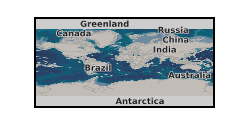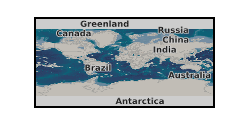Scottish Association for Marine Science
Type of resources
Topics
Keywords
Contact for the resource
Provided by
Years
Formats
Representation types
Update frequencies
Resolution
-
QICS Paper: Impact and recovery of pH in marine sediments subject to a temporary carbon dioxide leak

A possible effect of a carbon dioxide leak from an industrial sub-sea floor storage facility, utilised for Carbon Capture and Storage, is that escaping carbon dioxide gas will dissolve in sediment pore waters and reduce their pH. To quantify the scale and duration of such an impact, a novel, field scale experiment was conducted, whereby carbon dioxide gas was injected into unconsolidated sub-sea floor sediments for a sustained period of 37 days. During this time pore water pH in shallow sediment (5 mm depth) above the leak dropped >0.8 unit, relative to a reference zone that was unaffected by the carbon dioxide. After the gas release was stopped, the pore water pH returned to normal background values within a three-week recovery period. Further, the total mass of carbon dioxide dissolved within the sediment pore fluids above the release zone was modelled by the difference in DIC between the reference and release zones. Results showed that between 14 and 63% of the carbon dioxide released during the experiment could remain in the dissolved phase within the sediment pore water. This is a publication in QICS Special Issue - International Journal of Greenhouse Gas Control, Peter Taylor et. al. Doi:10.1016/j.ijggc.2014.09.006.
-

Carbon capture and storage (CCS) is a way of possibly reducing impacts from fossil fuel emissions by injecting large volumes of carbon dioxide into appropriate geological formations. Some of the existing and proposed storage sites are below the seabed. In order to better understand the environmental impacts of leaks from a sub-surface marine storage facility and to investigate how leaks or potential leaks could be detected, a world-first experiment consisting of an artificial carbon dioxide release from below the seabed was undertaken in 2012. The need for accurate deployments and re-deployments of measurement equipment, the retrieval of biological and sediment samples within very specific areas of the release site and the in-situ measurement of escaping gas volumes, necessitated an extensive scientific diving program. Diving was also employed to determine the most optimum experimental site prior to the program’s initiation and to map the site prior to the beginning of the experiment. Diving also proved to be an essential tool (through observation, photography and videography) in recording the progress of the experiment and the physical interactions and impacts arising from managing a large multi-partner, multi-discipline research program. This is a publication in Diving for Science 2014: Proceedings of the American Academy for Underwater Sciences 33rd Symposium, Martin D.J. Sayer et. al. http://www.aaus.org/uploads/protected/files/publications/symposium_proceedings/diving_for_science_2014.pdf
-

A two-fluid, small scale numerical ocean model was developed to simulate plume dynamics and increases in water acidity due to leakages of CO2 from potential sub-seabed reservoirs erupting, or pipeline breaching into the North Sea. The location of a leak of such magnitude is unpredictable; therefore, multiple scenarios are modelled with the physiochemical impact measured in terms of the movement and dissolution of the leaked CO2. A correlation for the drag coefficient of bubbles/droplets free rising in seawater is presented and a sub-model to predict the initial bubble/droplet size forming on the seafloor is proposed. With the case studies investigated, the leaked bubbles/droplets fully dissolve before reaching the water surface, where the solution will be dispersed into the larger scale ocean waters. The tools developed can be extended to various locations to model the sudden eruption, which is vital in determining the fate of the CO2 within the local waters. This is a publication in Marine Pollution Bulletin, Marius Dewar et. al. doi:10.1016/j.marpolbul.2013.03.005.
-

Carbon capture and storage is a mitigation strategy that can be used to aid the reduction of anthropogenic CO2 emissions. This process aims to capture CO2 from large point-source emitters and transport it to a long-term storage site. For much of Europe, these deep storage sites are anticipated to be sited below the sea bed on continental shelves. A key operational requirement is an understanding of best practice of monitoring for potential leakage and of the environmental impact that could result from a diffusive leak from a storage complex. Here we describe a controlled CO2 release experiment beneath the seabed, which overcomes the limitations of laboratory simulations and natural analogues. The complex processes involved in setting up the experimental facility and ensuring its successful operation are discussed, including site selection, permissions, communications and facility construction. The experimental design and observational strategy are reviewed with respect to scientific outcomes along with lessons learnt in order to facilitate any similar future. This is a publication in QICS Special Issue - International Journal of Greenhouse Gas Control, Peter Taylor et. al. Doi:10.1016/j.ijggc.2014.09.007.
-
The dataset details global positioning system (GPS) locations recorded for survey quadrats at six UK saltmarsh sites. Three of the sites were in Morecambe Bay, North West England and three of the sites were in Essex, South East England, each of these sites consisted of a salt marsh area and adjacent mudflat area. Each site comprised 22 quadrats on the unvegetated mudflat and 22 quadrats on the salt marsh. The locations indicated by this dataset correspond to the south-east corner of the quadrats which were 1m square and oriented with their sides aligned North-South and East-West. We combined spatial data relating to the environs of the study sites from a number of sources (Ordnance Survey Digital Terrain Models, Ordnance Survey Boundary Line, Environment Agency Saltmarsh Extents, Natural England Priority Habitat Inventory). These were rasterised and quadrat values were extracted on a pointwise basis for elevation and proximity (distance to creek, habitat edge and high water mark). Tidal height was calculated with reference to the relevant Tidal Gauge and Admiralty Standard Port information. This data was derived as part of Coastal Biodiversity and Ecosystem Service Sustainability (CBESS): NE/J015644/1. The project was funded with support from the Biodiversity and Ecosystem Service Sustainability (BESS) programme. BESS is a six-year programme (2011-2017) funded by the UK Natural Environment Research Council (NERC) and the Biotechnology and Biological Sciences Research Council (BBSRC) as part of the UK's Living with Environmental Change (LWEC) programme. Full details about this dataset can be found at https://doi.org/10.5285/78a2cab5-dca5-411b-ac5b-c2c080928b1d
-
The dataset comprises 65 hydrographic data profiles, collected by a conductivity-temperature-depth (CTD) sensor package, from across the Inner Seas off the West Coast of Scotland and the North East Atlantic Ocean (limit 40W) areas specifically the Extended Ellett Line (a section of stations that run from Ardnamurchan Point in Scotland to Rockall and on to Iceland, ending close to the volcanic island of Surtsey). Data were collected during October and November of 2005. A complete list of all data parameters are described by the SeaDataNet Parameter Discovery Vocabulary (PDV) keywords assigned in this metadata record. The data were collected by the Scottish Association for Marine Science as part of the Northern Seas Programme (NSP).
-
The dataset comprises 15 hydrographic data profiles, collected by a conductivity-temperature-depth (CTD) sensor package, from across the North East Atlantic Ocean (limit 40W) area specifically the shelf seas to the west of Scotland, during June and July of 2009. A complete list of all data parameters are described by the SeaDataNet Parameter Discovery Vocabulary (PDV) keywords assigned in this metadata record. The data were collected by the Scottish Association for Marine Science as part of the Oceans 2025 programme.
-
The Northern Seas Programme dataset comprises hydrographic, biogeochemical, biological and meteorological data. Hydrographic profiles provided measurements of parameters such as temperature, salinity, fluorescence and dissolved oxygen, while current velocities and acoustic backscatter were also measured. A comprehensive water sampling program permitted the collection of biogeochemical data including concentrations of various organic compounds, dissolved gas concentrations and radioactivity. Water samples were also analysed for phytoplankton, zooplankton and viruses. Larger biological samples were obtained from the water column using trawl nets and cetacean distributions were monitored using hydrophone arrays. Sediment samples were collected at various locations and analysed for biogeochemical parameters and zoobenthos. Sample data were supplemented by those derived from experiments, while bathymetry and meteorological parameters were measured across the study area. Data collection was undertaken in the Irish and northern North Seas, across the NE Atlantic and up to the marginal Arctic pack ice zone. This includes the territorial waters of the UK, Norway and the Russian Arctic, and extends from coastal fjords to the ocean margins. The data were collected during the period 2001-2007 over a number of cruises: RRS Discovery cruise D257, RRS James Clark Ross cruises JR75 and JR127, RRS Charles Darwin cruise CD176 and FS Poseidon cruise PO300/2. Measurements were taken using a variety of instrumentation, including conductivity-temperature-depth (CTD) profilers with attached auxiliary sensors, bathymetric echosounders, sediment samplers, trawl nets and acoustic Doppler current profilers (ADCPs), while incubation chambers were used for shipboard experiments. The programme was designed to advance the understanding of how marine systems in Northern Seas respond to environmental and anthropogenic change and was developed in three themes: Theme A - Understanding fjordic systems insights for coastal and oceanic processes; Theme B - Ocean Margins: the interface between the coastal zone and oceanic realm; Theme C - Measuring and modelling change: sea sensors and bioinformatics. Theme B included the Ellett Line Time Series. The Northern Seas Programme was co-ordinated by the Scottish Association for Marine Science (SAMS). Data from the programme are held at the British Oceanographic Data Centre.
-
The dataset comprises 82 hydrographic data profiles, collected by a conductivity-temperature-depth (CTD) sensor package, from across the North Atlantic Ocean area specifically the Ellett line CTD stations from Sound of Mull to Rockall, on the Wyville Thomson Ridge and in the Minch. The data were collected during July and August of 2003. A complete list of all data parameters are described by the SeaDataNet Parameter Discovery Vocabulary (PDV) keywords assigned in this metadata record. The data were collected by the Scottish Association for Marine Science as part of the Northern Seas Programme (NSP).
-
The dataset comprises 86 hydrographic data profiles, collected by a conductivity-temperature-depth (CTD) sensor package, from across the North East Atlantic Ocean (limit 40W) area specifically the the Extended Ellett Line, that runs from Iceland to Rockall and on to Ardnamurchan Point in Scotland, during June of 2009. A complete list of all data parameters are described by the SeaDataNet Parameter Discovery Vocabulary (PDV) keywords assigned in this metadata record. The data were collected by the Scottish Association for Marine Science as part of the Oceans 2025 programme.
 NERC Data Catalogue Service
NERC Data Catalogue Service